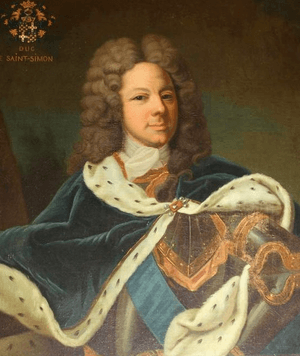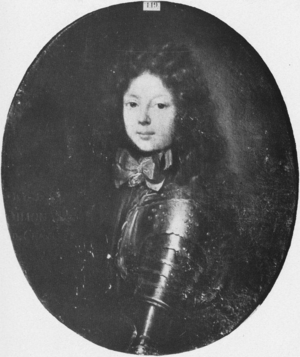Louis de Rouvroy, duc de Saint-Simon facts for kids
Quick facts for kids Louis de Rouvroy |
|
|---|---|
| Duke of Saint-Simon | |
 |
|
| Spouse(s) | Marie Gabrielle de Durfort |
| Issue | |
| Charlotte, Princess of Chimay Jacques Louis, Marquis of Ruffec Armand Jean |
|
| Father | Claude de Rouvroy |
| Mother | Charlotte de L'Aubespine |
| Born | 16 January 1675 Paris, France |
| Died | 2 March 1755 (aged 80) Paris, France |
Louis de Rouvroy, Duke of Saint-Simon (born January 16, 1675 – died March 2, 1755), was a French soldier, diplomat, and famous writer of memoirs. He was born in Paris, France. His family had a special noble title called a duché-pairie, which was given to his father, Claude de Rouvroy, in 1635. This title was very important to Louis de Saint-Simon throughout his life and writing. He was the second and last Duke of Saint-Simon.
His huge collection of memoirs is a classic of French literature. They give a very detailed and lively look at the royal court of King Louis XIV at Versailles. They also describe the time when France was ruled by a Regent at the beginning of King Louis XV's reign.
Contents
What Was a Peerage of France?
In France, not all noblemen were "peers." The peerage of France was a very special group of nobles. They were thought to be the best of the French nobility. Being a peer meant you had a special legal position. Peers could be part of the Parlement of Paris, which was France's highest court. A peerage title was usually linked to a specific piece of land, like a dukedom.
Saint-Simon always dreamed of turning France's peers into a powerful "Great Council of the Nation." If he had succeeded, French history might have been very different!
The main home of Saint-Simon's family was at La Ferté-Vidame. His father bought this castle after he became a duke. This is where Saint-Simon wrote his famous Mémoires.
Louis de Saint-Simon's Life
Louis's father, Claude, was the first duke. He was a tall, quiet man who loved hunting. Louis de Saint-Simon was very different. He loved to talk, was much shorter, and preferred being indoors. His father had been a favorite hunting friend of King Louis XIII. King Louis made his father a duke in 1635. Louis de Saint-Simon was born when his father was 68 years old. Among France's eighteen dukes, Saint-Simon's family ranked thirteenth.
His mother, Charlotte de L'Aubespine, came from an important noble family. She was a strong woman who made the rules in their home. She became even more powerful as she grew older. Louis was well-educated, mostly by his mother. King Louis XIV and Queen Marie-Thérèse were his godparents.
After studying with the Jesuits, Louis joined the army in 1692. He fought in the Siege of Namur and the Battle of Neerwinden. Early in his career, he started to argue about the proper ranking of French peers. This was against the wishes of his general, François-Henri de Montmorency.
In 1695, he married Marie-Gabrielle de Durfort. Her father was a marshal of France. Saint-Simon seemed to respect and love his wife, which was not always common at that time. She sometimes helped him calm down his strong ideas.
Louis did not get promoted further in the army, so he left in 1702. This made King Louis XIV unhappy. Saint-Simon managed to keep his place at court, but it was difficult. He then became very involved in court politics at Versailles. He gathered information from many people, from dukes to servants. This helped him collect a lot of secret details for his later writings.
Saint-Simon did not play a major public role at court. He was supposed to become an ambassador to Rome in 1705, but the trip was canceled. Eventually, he became close to Philippe II, Duke of Orléans, who was King Louis XIV's nephew and would later become the regent. This friendship did not please King Louis, but it gave Saint-Simon a clear position at court. He also became friends with Louis, Duke of Burgundy, who was next in line for the French throne.
Saint-Simon did not like King Louis XIV's children. This was partly because they were given higher ceremonial ranks than France's peers. The Mémoires show that Saint-Simon had many enemies at court. However, it's important to remember that he wrote these memories 30 years later, when he was older and perhaps a bit disappointed. He actually had good relationships with most of his fellow courtiers.
When King Louis XIV died, Saint-Simon hoped his dreams would come true. The Duke of Orleans became regent, and Saint-Simon was appointed to his council. But his idea of France being ruled by the noble elite was not put into action. This showed that he had little real power with the Regent.
In 1721, he was sent as a special ambassador to Spain. His job was to help arrange a marriage between King Louis XV and Infanta Mariana Victoria of Spain. This marriage never happened. However, while in Spain, he did get a special Spanish noble title called a grandeeship. Even though he caught smallpox, he was happy with his work there. He gained two ducal titles (grandees were seen as dukes in France). Unlike many other nobles, Saint-Simon was not interested in getting rich from his positions. His finances actually got worse because his trip to Spain was so expensive.
After returning to France, he was not very involved in public life. He lived for more than thirty more years. His wife died in 1743, and his oldest son died shortly after. He had other family problems and was deep in debt. The dukedom he was so proud of ended with him, as his only granddaughter had no children.
He died in Paris on March 2, 1755. He had lived longer than most of his generation and spent his family's money. However, his family name remained known. A distant relative, Claude Henri de Rouvroy, comte de Saint-Simon, born five years after the Duke's death, is remembered as an important thinker who influenced socialism.
After his death, all his belongings, including his writings, were taken by the King. His Mémoires were kept secret for a long time. They were only shared through private copies until the original manuscript was returned to his family in 1828. This seizure actually helped save his memoirs from being lost.
Why Saint-Simon Is Famous as a Writer
Even though Saint-Simon lived a long and important life, his actions were not always the most famous part. He became very famous after his death because of his writing. He wrote constantly, starting very early in life. He wrote down all the gossip he heard, all his long legal fights about noble rankings, and many other things. Most of his writings were taken by the King, and it took a long time for them to be fully published.
Saint-Simon's Mémoires feel very real. He could be petty and unfair to his enemies. He also loved to gossip. But he was also a great storyteller and very good at describing people. Some compare him to famous historians like Tacitus and Livy. His writing can be hard to read in small parts because his most interesting sections are sometimes hidden within long, less exciting parts. He used very creative and unusual words. He is even thought to have been the first to use the word "intellectual" as a noun, and to use "patriot" and "publicity" in the way we use them today.
His most famous passages, like the story of the Dauphin's death or the "Bed of Justice" where his enemy, Louis-Auguste de Bourbon, duc du Maine, lost his rank, show his great skill. But what makes his Mémoires truly special are the small, sudden descriptions he gives. For example, he called bishops "purple pedants." He described one politician as having the "appearance of a disgruntled cat." The main reason his Mémoires are so interesting is his new and clever use of words and phrases.
His writings had a big impact on many other famous writers, including Tolstoy, Flaubert, and Proust.
Family
Saint-Simon married Marie-Gabrielle de Durfort on April 8, 1695, in Paris. They had three children:
- Charlotte de Rouvroy (born September 8, 1696 – died September 29, 1763) married Charles-Louis de Henin-Liétard d'Alsace, the "Prince of Chimay." They had no children.
- Jacques Louis de Rouvroy, Duke of Ruffec (born July 29, 1698 – died July 15, 1746) married Cathérine Charlotte Thérèse de Gramont in 1727. They had no children.
- Armand-Jean de Rouvroy (born April 12, 1699 – died May 20, 1754) married Marie Jeanne Louise, daughter of Nicolas Prosper Bauyn d'Angervilliers. They had one daughter.
His granddaughter, Marie Christine, married a son of the Princess Louise Hippolyte of Monaco in 1749. She became the "Countess of Valentinois."
See also
 In Spanish: Louis de Rouvroy, duque de Saint-Simon para niños
In Spanish: Louis de Rouvroy, duque de Saint-Simon para niños


